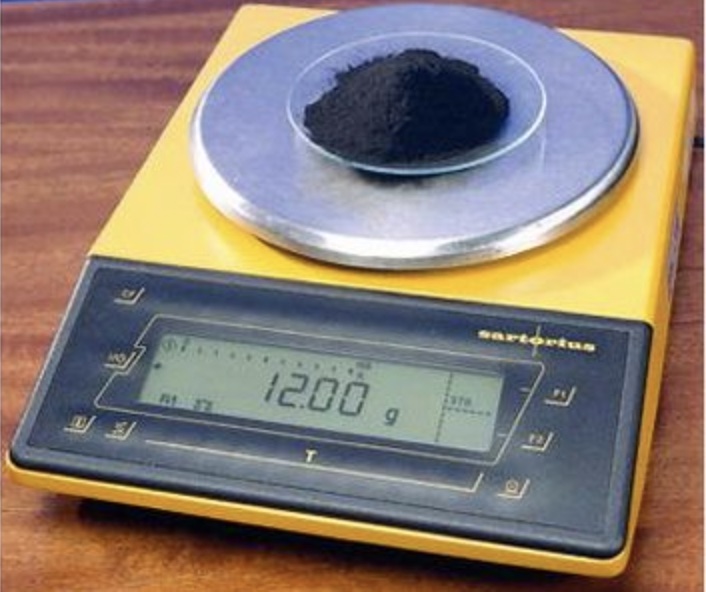Topic 1
 1. Stoichiometric relationships (
1. Stoichiometric relationships (
 13.5 hours)
13.5 hours)
Some educational background

A mole of carbon
Topic 1 has a history of changing its name even though the content has essentially remained unchanged. It used to be called 'Stoichiometry' then it became 'Quantitative chemistry' and now it has become 'Stoichiometric relationships'.
In some ways it makes sense to put stoichiometric relationships as the first topic on the syllabus. In the early years of chemistry the formulas of substances were first determined by quantitative analysis. The quantitative work of Lavoisier and others helped to make chemistry a modern scientific subject and moved it away from alchemy. However now that an understanding of chemistry is firmly based on atomic theory I personally think that it makes sense to start teaching IB Diploma Chemistry with the structure of the atom before tackling Topic 1. I know that many teachers follow a similar approach.
If you ask students what they find most difficult about IB Chemistry then the chances are that some (many?) of the concepts in stoichiometric relationships will feature high on their list. When we mark Paper 2 it is often this topic which distinguishes the student who does well from the student who is struggling. The problem is that the contents of Topic 1 are not isolated. If a student has problems with basic chemical calculations then topics such as equilibrium, acids and bases, reaction kinetics and redox chemistry will all be so much more difficult – particularly when it comes to problem solving. It is probably the one topic that you never really finish teaching but you reinforce throughout the course particularly through practical work and especially when data processing is involved.
Essential ideas
The three essential ideas given at the start of each of the three sub-topics are fairly self-evident. Any student who has studied some chemistry before will already know that the physical and chemical properties of substances depend on the ways in which different atoms combine. The second one states that the concept of a mole makes it possible to correlate the (extremely large) number of particles with the mass of the substance that can be measured.The last idea is that, by applying Avogadro's law, mole ratios in chemical equations can be used to calculate reacting ratios by mass and gas volume.
Problems faced by students
One of the problems with dealing with the quantitative chemistry in 'Stoichiometric relationships' early in the course is that some students have not yet fully developed their ability to deal with abstract concepts. There have been several studies into problems that students have in understanding the concept of the mole. In one such study in 1995 in the Journal of Research in Science Teaching the conclusion reached by the authors, John Staver and Andrew Lumpe was that the difficulties were caused by:
- failing to define the mole in terms of 12C.
- defining the mole as Avogadro's number.
- defining the mole as a mass.
- constructing a logical argument in vague terms or by using improper knowledge.
These conclusions are similar to those found in a literature search and published in the International Journal of Science Education by Jenni Case in 1999. In this article three main reasons were given for student’s difficulty. These were:
- the mole is seen as a mass not an amount and students experience general difficulties with the concept of amount.
- The mole is defined in terms of Avogadro’s number, NA, but not in terms of 12C. (Note that the IB tends to use the symbol L in place of NA).
- Mole-related properties of gases (equal volumes for equal amounts) are extended to liquids and solids and there is confusion over when the volume of 22.4 dm3 or 22.7 dm3 applies and does not apply. (Note that the IB now uses 22.7 dm3 as the molar volume of a gas at STP.)
What is interesting is that many of these studies were done with university students as well as high school students so it is not surprising that some students aged 16 or 17 find difficulties. I think that as you teach Topic 1 it is worth remembering these problems. It can be useful to share them with your students so that they do not feel worthless if they are struggling. In my experience it is not worth spending hours demoralising students who do have problems by giving them more and more questions to do. It is better to move on and hope that the steady drip feed of examples requiring quantitative chemistry in the other topics will provide that further practice in context. As their mental faculties develop the concept will be absorbed when they are ready. Hopefully with your guidance this will occur during the two year IB course and not later.
The links on the left give you teaching tips etc. for each of the sub-topics together with questions and answers for each sub-topic.
Once you have finished teaching the whole topic you can give the multiple choice tests on Stoichiometric relationships (together with answers):![]()
![]()
![]() Topic 1 (1) and/or
Topic 1 (1) and/or ![]()
![]()
![]() Topic 1 (2)
Topic 1 (2)

 IB Docs (2) Team
IB Docs (2) Team